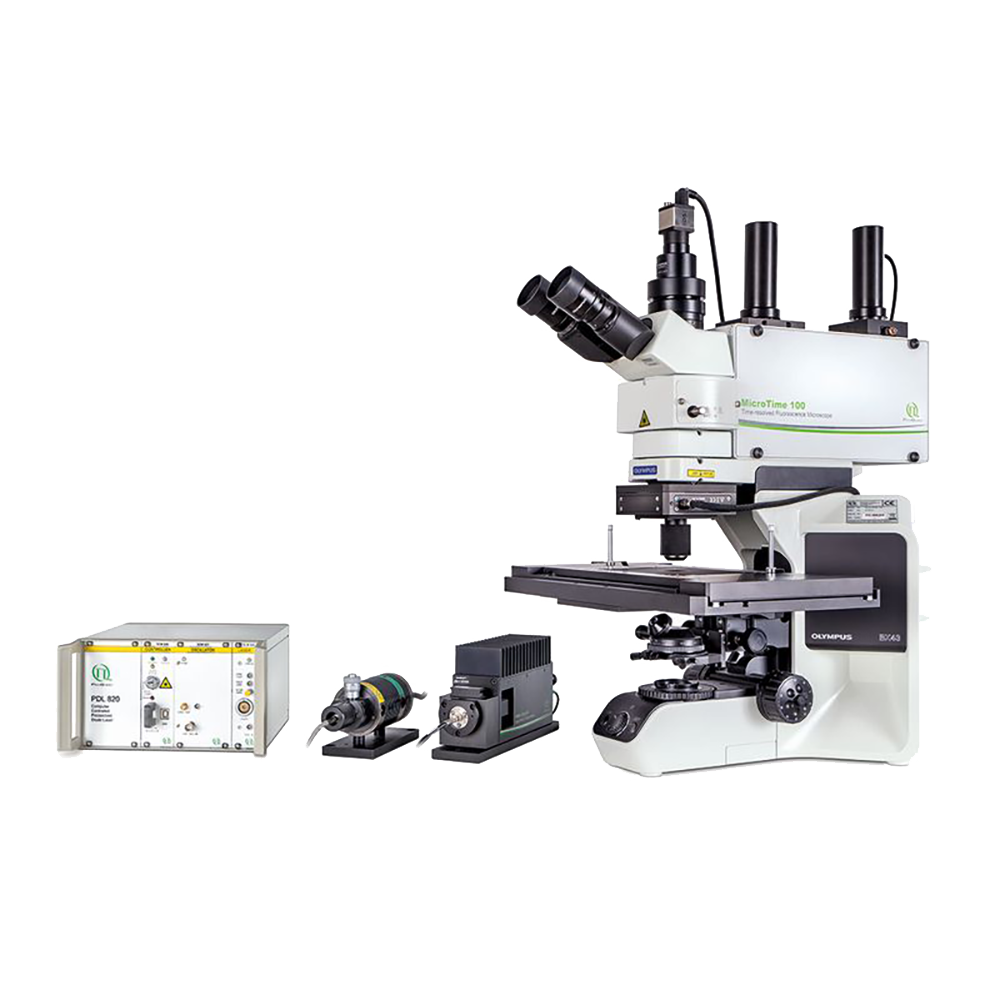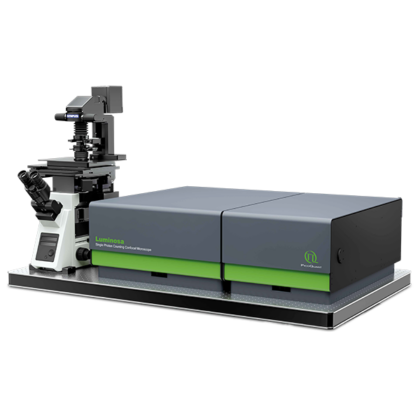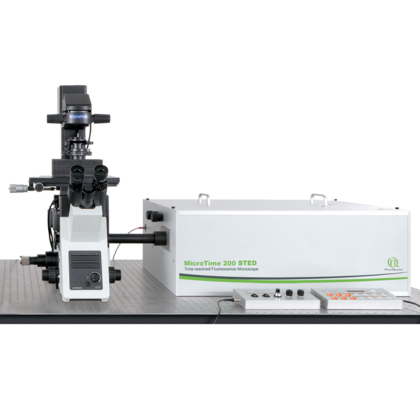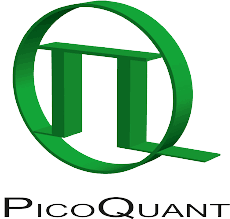Upright Time-resolved Fluorescence Microscope
- Complete system with laser combining unit, upright microscope body and detection unit
- Pulsed diode lasers with wavelengths from 375 nm to 1060 nm
- Multiple detector options for up to four detection channels
- XYZ scanning piezo stage for 3D lifetime imaging
- Optional wide range scanner with a scan range up to several cm
Applications
The MicroTime 100 is an upright time-resolved confocal microscope, that can be used to perform several applications such as:
- Time-Resolved Fluorescence
- Fluorescence Lifetime Imaging (FLIM)
- Phosphorescence Lifetime Imaging (PLIM)
- Fluorescence Correlation Spectroscopy (FCS)
- Fluorescence Lifetime Correlation Spectroscopy (FLCS)
- Foerster Resonance Energy Transfer (FRET)
- Pulsed Interleaved Excitation (PIE)
- Pattern Matching Analysis
- Time-Resolved Photoluminescence (TRPL)
- TRPL Imaging
- Antibunching
- Single Molecule Spectroscopy / Detection
The MicroTime 100 is an idea tool for the study of time-resolved photoluminescence of solid samples such as wafers, semiconductors or solar cells. The system is based on a conventional upright microscope body that permits easy access to a wide range of sample shapes and sizes. The MicroTime 100 can be supplied with either manual scanning or with a 3D piezo scanner with either µm or cm resolution.
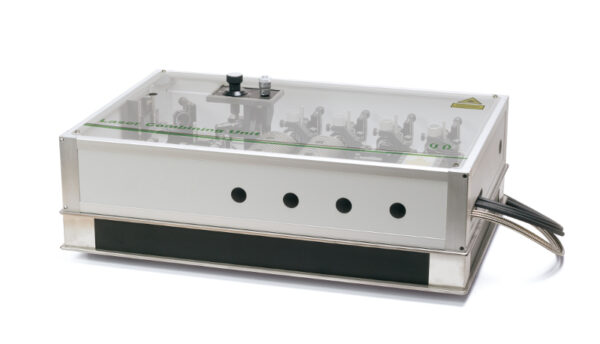
Flexible excitation subsystem, ideally suited for many applications
The MicroTime 100‘s excitation subsystem is highly customisable and extensible,, offering the following:
- A laser driver from PicoQuant’s PDL Series with one or more corresponding diode laser heads
- Multiple excitation modes: picosecond pulsed, continuous wave (cw) or burst
- Available wavelengths: from 375 to 1064 nm
- Direct coupling of to the MicroTime 100 via optical fibre
- Optional integration of up to 8 laser heads in a single Laser Combining Unit (LCU) for streamlined operation
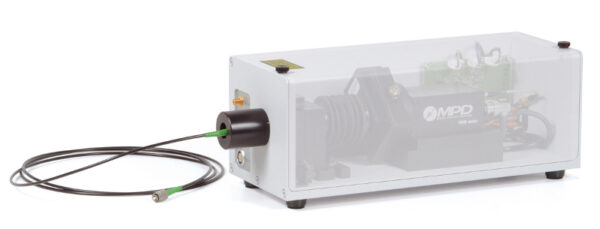
Photoluminescence detection subsystem with single photon sensitivity
A core design principle for the MicroTime 100‘s detection subsystem is to couple maximum flexibility with single photon sensitivity. The detection subsystem provides:
- High light collection efficiency
- Up to four detection channels which are coupled to the microscope via a multimode fibre
- A variety of highly sensitive detectors from the PMA or PMA Hybrid Series or SPADs, optimised for various wavelength ranges, signal brightness, low dark counts or for after-pulsing free detection

Time-Correlated Single Photon Counting (TCSPC) based data acquisition with picosecond timing resolution
The MicroTime 100 leverages the power of our Harps product line of TCSPC units and event timers, which offer the following advantages:
- Time-tagging electronic based on Time-Correlated Single Photon Counting (TCSPC) in combination with the unique Time-Tagged Time-Resolved (TTTR) mode
- Use TTTR data acquisition to perform conventional lifetime measurements, Fluorescence Lifetime Imaging (FLIM) or TRPL imaging
- Easily measure photoluminescence lifetimes ranging from a few picoseconds to up to ms with a single set-up
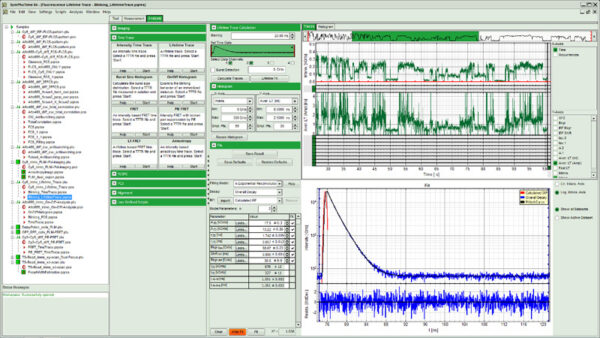
Intuitive data handling and analysis
Based on the sophisticated data collection and handling, the system software SymPhoTime 64 supports a multitude of methods, such as intensity time trace, burst analysis, lifetime histogramming, Fluorescence Correlation Spectroscopy (FCS), Fluorescence Lifetime Correlation Spectroscopy (FLCS), Fluorescence Lifetime Imaging (FLIM), TRPL Imaging and Förster Resonance Energy Transfer (FRET), to name only a few.
SymPhoTime 64 data handling maintains a transparent data structure where all derived data is maintained in one workspace, including a log file to keep track of all measurement and analysis steps.
A large number of algorithms for those methods are already integrated in SymPhoTime 64, providing a analysis platform for ready-to-publish data. At the same time, SymPhoTime 64 offers enhanced flexibility for the integration of novel, cutting edge algorithms by the user. A dedicated scripting language interface allows to modify and expand the analysis routines. In addition to data analysis within SymPhoTime 64, data can be exported to standard formats for external analysis.































